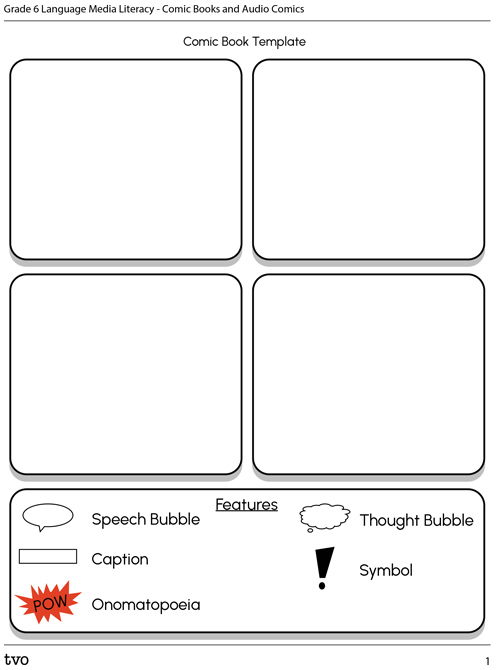Minds On
Comic books
If you were a superhero, what would be your superpower? What would be your name? Using a method of your choice, draw or describe your superhero. Include your superhero name, superhero outfit, and your superpower. Is your superhero a real person? A social justice hero? If possible, share your superhero with a partner.
Superheroes are often found in books that combine words and images. Do you know what these books are called? That’s right! Comic books.
Comic books aren’t just a story with pictures like a picture book. With comic books, the images and words are entwined. Comic books are usually a panel of images with text indicating dialogue, sound effects, and more.
Audio comics
Comics used to be just in print but with technology, comics are expanding. You can access comics digitally now. Some companies are even creating audio comics with sound effects and music. Sometimes they use existing comics and have voice actors bring the comics to life.
Graphic novels
Graphic novels are similar to comic books but there are a few differences. Graphic novels are longer than comic books and contain a whole story from beginning to end within them. Comics on the other hand are serialized. This means that every comic book issue is part of a larger story.

Action
Task 1: Elements of a comic book
Comic books tell stories through a series of illustrations and very little text. Like many other stories, they contain common story elements (e.g., beginning, middle, and end) which are conveyed with the help of speech and dialogue bubbles. We are going to explore and familiarize ourselves with different comic book elements and text features. This will help you to better understand this particular genre so that you can create your own comic book or audio comic.
Comic books have distinct elements that make them unique. Using your method of choice, review the following images and make a list of the elements of a comic book.
Task 2: Onomatopoeia
There are certain key elements that are a part of every printed or digital comic book or comic strip. One of these elements is words that express sound. These are called onomatopoeias. Examples include, “crash,” “bang,” and “pow.” An onomatopoeia is a word that sounds like the meaning of the word. Here are a few other examples of onomatopoeias that are commonly used in comic books: screech, arf, zap, eek, and beep.

If you choose to develop a printed or digital comic book, you may want to practice drawing or describing a Pop Art inspired onomatopoeia. Use the Internet to search for how-to videos or written instructions. And just like that, you’ll become a comic book artist!
Knowledge check
Let's review some of the features of a comic book. For each term, select the corresponding definition.
Consolidation
Task 1: Create a comic book or audio comic
Create an outline of your comic book or audio comic. Use the following questions to plan out your story:
- What kinds of characters will you feature in your comic? Who is the main character?
- What is the main character’s goal? What are they working to accomplish? Is their mission a social justice issue?
- Who is the antagonist or villain?
- Where does the story take place?
- What is the problem? What is the solution?

Will you create a comic book or an audio comic book?
If you have decided to develop an audio comic, consider what each character will sound like, what sound effects you want to use, and which music and/or audio files you will add to your comic recording. Also, be sure to include detailed descriptions for each scene. There are some free sound effects websites on the Internet so don’t forget to check those out! Use the following checklist to make sure your comic book or audio comic book contain the right elements and features.
Features of a Comic Book
Complete the Comic Book Template in your notebook or use the following fillable and printable document.
When you complete your outline, revise and edit your work. If possible, find a partner to help you do this.
Reflection
As you read through these descriptions, which sentence best describes how you are feeling about your understanding of this learning activity? Press the button that is beside this sentence.
I feel...
Now, record your ideas using a voice recorder, text-to-speech, or writing tool.







